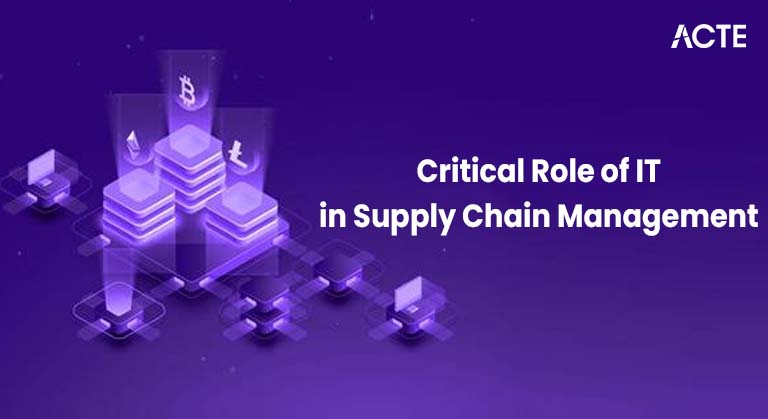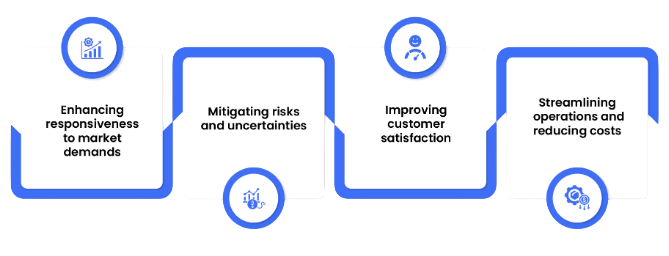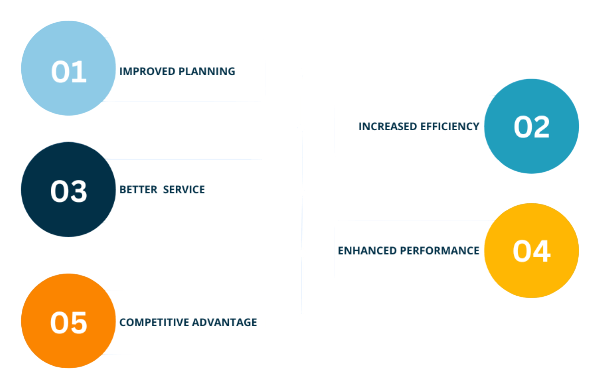
- Introduction to IT in Supply Chain Management
- How IT Enhances Supply Chain Visibility
- IT Systems and Technologies in SCM
- Role of IT in Demand Forecasting and Planning
- IT in Inventory Management and Optimization
- Impact of IT on Procurement and Supplier Management
- Challenges of Implementing IT in Supply Chain
- Conclusion
Introduction to IT in Supply Chain Management
Information Technology (IT) plays a vital role in modern supply chain management by enabling the seamless integration of processes, data, and stakeholders across the entire value chain. IT encompasses a wide range of tools and systems, including computer hardware, software applications, digital networks, and data analytics platforms. These technologies are used to collect, store, analyze, and distribute information efficiently, allowing organizations to make faster and more informed decisions. In the context of supply chain management, IT facilitates real-time communication and collaboration among suppliers, manufacturers, distributors, and retailers. It helps synchronize activities such as procurement, production planning, inventory management, transportation, and customer service. The implementation of Enterprise Resource Planning (ERP) systems is a key example of IT’s impact, providing a centralized platform where all departments can access and update critical business data, a process that can be effectively managed with PMP Training. This integration improves accuracy, reduces duplication of effort, and enhances overall visibility. Other essential IT tools include Warehouse Management Systems (WMS), which optimize storage, picking, and packing operations, and Transportation Management Systems (TMS), which support route planning, carrier selection, and shipment tracking. Advanced analytics and business intelligence platforms further enable companies to analyze historical trends, forecast demand, and identify inefficiencies or risks in the supply chain. The use of IT not only enhances operational efficiency but also strengthens a company’s ability to adapt to changing market conditions. In today’s global and highly competitive environment, IT acts as a strategic enabler of supply chain agility, responsiveness, and innovation. By investing in robust IT infrastructure and digital capabilities, organizations can improve service levels, reduce costs, and build more resilient and customer-focused supply chains.
Are You Interested in Learning More About PMP? Sign Up For Our PMP Certification Training Today!
How IT Enhances Supply Chain Visibility
One of the most critical contributions of Information Technology in supply chain management is improving visibility across the entire supply network. Supply chain visibility refers to the ability to track products, inventory, and shipments at every stage, from raw material sourcing to final delivery. This visibility is essential for ensuring efficiency, responsiveness, and customer satisfaction in today’s fast-paced and interconnected business environment. Technologies such as Radio Frequency Identification (RFID), barcoding, Global Positioning System (GPS) tracking, and Internet of Things (IoT) devices play a major role in enhancing visibility, similar to how teams Learn Burndown Charts With Jira for project transparency. These tools collect real-time data on the location, condition, and movement of goods, allowing companies to monitor their supply chain assets with precision. For example, RFID tags can be used to track individual items as they move through warehouses and distribution centers, while GPS enables live tracking of shipments in transit. IoT sensors can provide information on temperature, humidity, and handling conditions, which is especially valuable for perishable or sensitive goods. Cloud-based platforms further strengthen supply chain visibility by integrating data from various sources across the organization and its partners. These platforms make it possible to share information instantly with suppliers, carriers, and customers, creating a unified and transparent view of the entire supply chain.

With this level of connectivity, managers can quickly detect disruptions, identify bottlenecks, and make proactive decisions to minimize delays and reduce costs. Improved supply chain visibility leads to more accurate forecasting, better coordination among stakeholders, shorter lead times, and higher service levels. Ultimately, it enhances an organization’s ability to respond to market demands and strengthens relationships with customers by ensuring timely and reliable delivery.
IT Systems and Technologies in SCM
- Enterprise Resource Planning (ERP) Systems: ERP integrates core business functions like procurement, production, sales, and finance, providing a unified source of accurate data for the entire organization.
- Warehouse Management Systems (WMS): WMS optimize warehouse activities such as receiving, inventory tracking, picking, packing, and shipping, improving operational efficiency and accuracy.
- Transportation Management Systems (TMS): TMS support transportation logistics by enabling route planning, carrier selection, shipment tracking, and freight cost management to reduce delays and expenses, much like the collaborative approach in What Is Scrum XP.
- Advanced Planning and Scheduling (APS) Tools: APS tools optimize production and distribution schedules by aligning demand forecasts with capacity constraints, ensuring timely and cost-effective delivery.
- Supply Chain Management (SCM) Software Platforms: SCM platforms offer comprehensive modules covering supplier relationship management, order processing, demand planning, and supply chain analytics.
- Automation of Routine Tasks: These IT systems automate repetitive and manual processes, reducing errors and freeing up staff to focus on higher-value activities.
- Support for Data-Driven Decisions: By consolidating and analyzing vast amounts of supply chain data, these systems enable managers to make informed decisions that enhance efficiency, responsiveness, and cost control.
- Importance of Accurate Demand Forecasting: Precise demand forecasting is critical in supply chain management to avoid costly stockouts and excess inventory.
- Use of Historical and Market Data: IT tools analyze past sales, market trends, seasonality, and external influences to create reliable demand forecasts, which can be better managed and implemented with PMP Training.
- Role of Machine Learning and AI: Advanced algorithms enhance forecast accuracy by detecting patterns, trends, and anomalies that traditional methods might miss.
- Collaborative Planning Platforms: These platforms enable suppliers, manufacturers, and retailers to share real-time demand data and adjust plans collaboratively.
- Reducing Forecast Errors: Integration and collaboration across the supply chain reduce discrepancies between forecasted and actual demand, minimizing inefficiencies.
- Alignment of Production and Demand: Improved forecasting helps synchronize production schedules with market demand, optimizing inventory levels and reducing waste.
- Support for Sales and Operations Planning (S&OP): IT tools facilitate cross-functional coordination, allowing teams to make aligned, data-driven decisions for overall supply chain efficiency.
- Automation of Procurement Processes: IT automates key procurement activities such as sourcing, purchase orders, contract management, and supplier evaluation, increasing speed and accuracy.
- E-Procurement Platforms: These digital marketplaces enable suppliers and buyers to connect, negotiate, and complete transactions efficiently in a centralized online environment.
- Supplier Relationship Management (SRM) Tools: SRM systems help track and monitor supplier performance, compliance, and risk factors to ensure quality and reliability.
- Data Analytics for Cost Savings: Analytics tools analyze procurement data to uncover opportunities for cost reduction and to evaluate supplier reliability, factors that influence the Project Manager Salary in India .
- Blockchain for Transparency and Security: Blockchain technology provides a secure, immutable ledger that enhances transparency and trust in procurement transactions.
- Enhanced Collaboration: IT fosters better communication and collaboration between procurement teams and suppliers, improving responsiveness and partnership quality.
- Improved Procurement Effectiveness: By reducing cycle times and increasing process efficiency, IT contributes to building more resilient and agile supply chains.
To Explore PMP in Depth, Check Out Our Comprehensive PMP Certification Training To Gain Insights From Our Experts!
Role of IT in Demand Forecasting and Planning

IT in Inventory Management and Optimization
Information Technology plays a crucial role in modern inventory management by enabling real-time visibility, accuracy, and control across multiple locations and channels. With the help of automated inventory management systems, companies can track stock levels, monitor inventory movement, and manage replenishment processes more efficiently. These systems continuously collect and analyze data to provide up-to-date information on product availability, reorder points, and safety stock requirements. Managers receive alerts when inventory drops below preset thresholds, ensuring timely restocking and preventing stockouts. Technologies such as Radio Frequency Identification (RFID) and barcode scanning further enhance inventory accuracy and operational speed. These tools minimize manual data entry, reduce human errors, and streamline processes such as receiving, picking, and shipping, aligning with the Phases of Project Management for efficient execution. Real-time tracking enabled by RFID allows for precise location identification of items within warehouses or retail stores, supporting better space utilization and faster order fulfillment. Advanced inventory systems often use optimization algorithms to recommend ideal order quantities and reorder timing. These algorithms analyze factors such as historical demand, lead times, and service level goals to balance inventory costs with product availability. As a result, companies can avoid both excess inventory and shortages, leading to more efficient use of working capital. Cloud-based inventory platforms enhance collaboration between supply chain partners by allowing shared access to inventory data. This transparency supports models like vendor-managed inventory (VMI), where suppliers can monitor stock levels and manage replenishment directly. Improved coordination with suppliers and customers helps streamline operations and align supply with demand more effectively. By leveraging IT in inventory management, businesses can achieve leaner operations, reduce carrying costs, and improve order accuracy and fulfillment rates. This contributes to stronger customer satisfaction and a more agile, cost-effective supply chain overall.
Are You Considering Pursuing a Master’s Degree in PMP? Enroll in the PMP Master Program Training Course Today!
Impact of IT on Procurement and Supplier Management
Challenges of Implementing IT in Supply Chain
Despite the many benefits that Information Technology solutions bring to supply chain management, their implementation can present several significant challenges. One of the primary obstacles is the high initial cost associated with acquiring and deploying advanced IT systems. This expense can be particularly daunting for small and medium-sized enterprises that may lack the financial resources to invest heavily in new technologies. Alongside cost, the complexity of these systems often requires specialized knowledge for installation, configuration, and maintenance, which can further hinder adoption. Another major challenge is the integration of new IT solutions with existing legacy systems. Many organizations operate with a variety of older software and hardware that may not easily communicate with newer platforms, raising questions like Why Do Scrum Masters Get Paid so Much as agile roles help bridge such gaps. This creates difficulties in creating a seamless flow of information and processes across the supply chain. Moreover, coordinating IT systems across multiple stakeholders, such as suppliers, logistics providers, and customers, can be complicated due to varying levels of technological capability and differing system standards. Data security and privacy concerns are also critical. As supply chains become more connected and data-driven, they are increasingly vulnerable to cyberattacks and data breaches. Organizations must invest in robust cybersecurity measures to protect sensitive information and maintain trust with partners and customers. Successful implementation also depends heavily on effective change management and employee training. Resistance to change and a lack of digital skills can slow down adoption and reduce the overall effectiveness of IT initiatives. Additionally, maintaining data quality and managing large volumes of information to avoid overload are ongoing challenges that require careful governance. Overcoming these barriers requires thorough strategic planning, strong executive support, and a phased approach to implementation. By addressing these challenges proactively, organizations can unlock the full potential of IT in transforming their supply chains.
Preparing for a PMP Job Interview? Check Out Our Blog on PMP Interview Questions and Answers
Conclusion
The role of Information Technology (IT) in supply chain management has become essential for companies striving to achieve operational excellence, responsiveness, and a competitive edge in today’s increasingly complex and globalized markets. IT provides the foundation for real-time data sharing across all stages of the supply chain, allowing organizations to have a clear and up-to-date view of inventory levels, shipment statuses, and production schedules. This transparency helps businesses anticipate customer demand more accurately and respond swiftly to changes in the market. Automation, powered by IT systems, streamlines numerous supply chain activities such as order processing, inventory replenishment, and shipment tracking. By reducing manual intervention, automation improves accuracy and speeds up operations, enabling companies to deliver products faster and more reliably, especially when guided by PMP Training. Furthermore, advanced analytics tools utilize vast amounts of supply chain data to generate insights, forecast trends, and identify potential risks or inefficiencies. These capabilities empower decision-makers to optimize inventory levels, balance costs, and enhance overall supply chain performance. Seamless collaboration facilitated by IT connects suppliers, manufacturers, logistics providers, and customers on integrated digital platforms. This interconnectedness fosters better communication, coordination, and alignment of goals across the supply chain network, which is vital for achieving agility and resilience. While implementing IT solutions can present challenges such as costs, integration issues, and the need for employee training, these obstacles are outweighed by the long-term benefits. As technology continues to advance, ongoing investments and innovation in IT will drive the development of smarter, more adaptive supply chains. Organizations that strategically embrace these digital tools and incorporate them into their business models will be better equipped to navigate uncertainty, improve customer satisfaction, and maintain a strong competitive position in the dynamic world of supply chain management.





